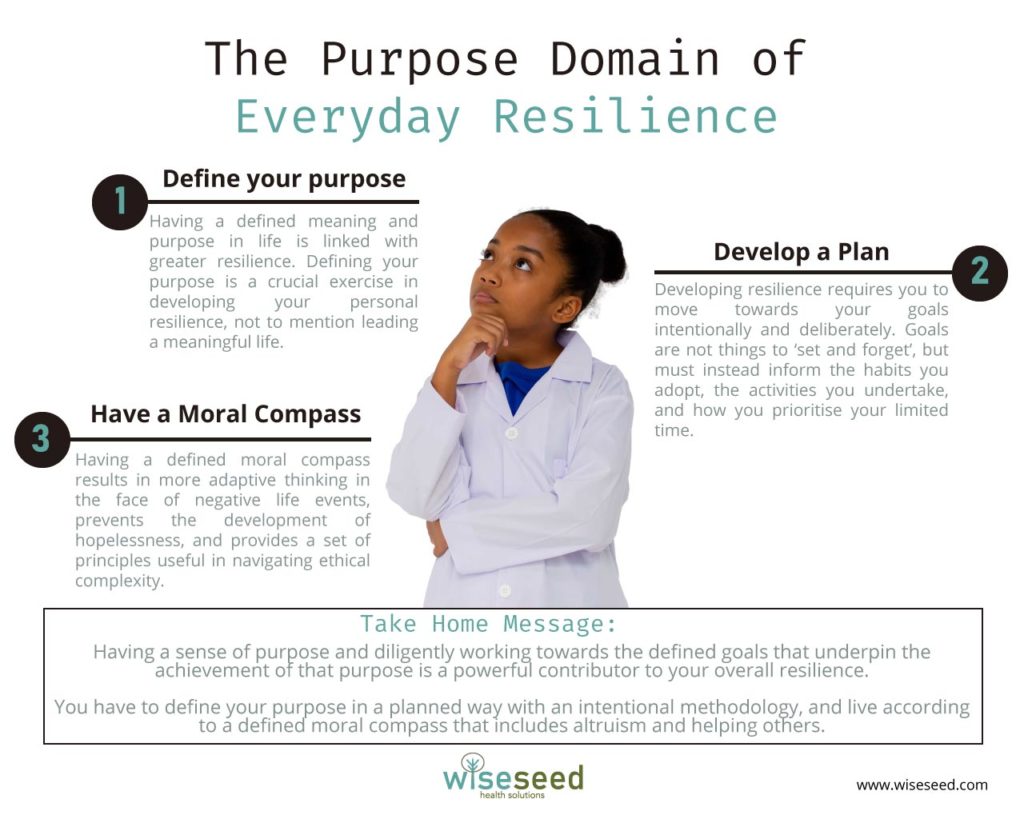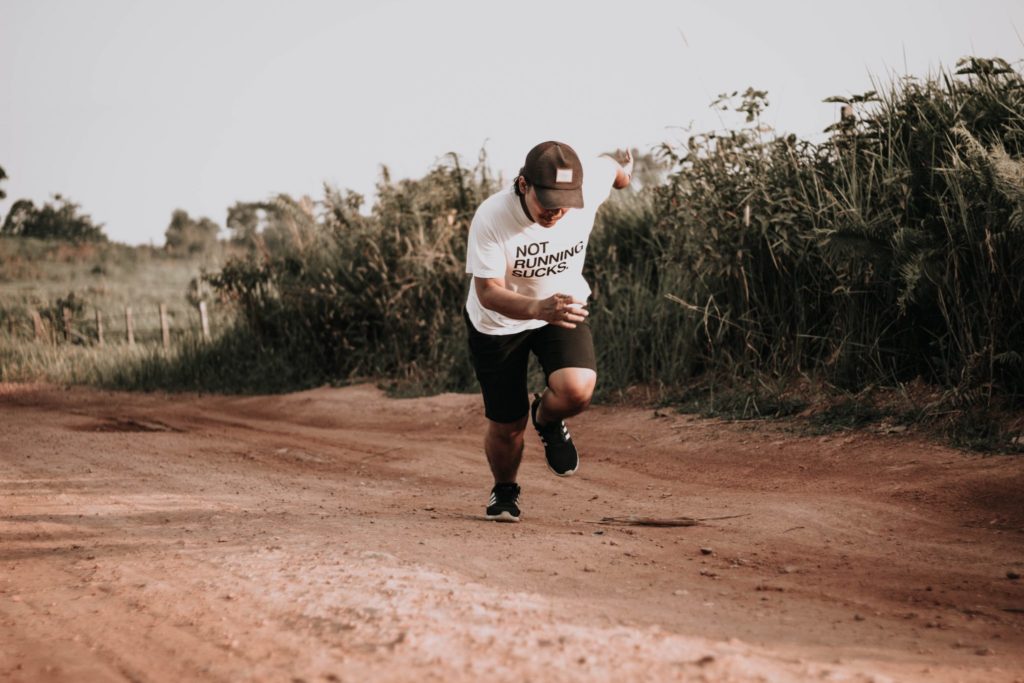The Purpose Domain of Everyday Resilience

“Some people never observe anything. Life just happens to them. They get by on little more than a kind of dumb persistence, and they resist with anger and resentment anything that might lift them out of that false serenity.” – Frank Herbert
Setting the Scene
In today’s article, we focus on the Purpose domain of the Everyday Resilience Framework. This is the fifth (and final) domain of the framework, and it builds on the content we’ve already covered in our articles relating to the Body, Community, Mind, and Spirit domains.
Creating a sense of personal purpose is hard, confronting, and often painful. However, if you self-define what your purpose is and routinely work towards achieving it over time, its contribution to your overall resilience is powerful (1). Conversely, a lack of purpose limits your overall potential for resilience and weakens the other domains of your everyday resilience.
Todays Domain: Purpose
At first glance, it may not be obvious how possessing a sense of ‘purpose’ contributes to your everyday resilience, or how a lack of purpose weakens your resilience potential.
In an earlier Wise Seed article, we discussed the era of adversity, transition, and accelerating change that we currently face. We live in an era of ‘saturation of distraction’. The challenge of the 21st century is shaping a sense of purpose in a world of unceasing and addictive entertainment, sophisticated influences that advocate for particular agendas, societal-wide phase transitions, and a lack of consensus on what ‘happiness’ is or how it is achieved.
In the face of such buffeting and powerful forces, it is easy to drift and become a passenger in your own life, but this makes you vulnerable to adversity and reduces your overall resilience. Instead, defining and acting on a self-defined purpose has positive implications for your personal resilience in two ways:
– It provides a consistent frame of reference for steering yourself through the chaos of life, creating a sense of mastery as you repeatedly orientate yourself towards clear goals against an always-changing environment (2, 3). This moves you towards success and achievement over time, and avoids an endless daily repetition of persistent reactivity and distraction.
– It helps you re-evaluate the hardships you face as potential new opportunities for achieving your goals and engaging in self-discovery (4).
Without a clear and driving purpose you risk avoiding challenge and adversity will deprive you of many critical opportunities for growth, making you dependent on the purpose and interpretations of other people who may be coming from an entirely different world view. This will only undermine your resilience. Thus, although it’s easy and comfortable to let life simply happen to you, such an approach will not cultivate resilience. Instead, you must actively work at your purpose domain to optimise your overall resilience.
Three Practices that will Build Your Resilience Domain
There are three practices you can apply that will build your purpose domain. These are:
1. define your purpose and its supporting goals
2. intentionally apply a methodology for how you achieve your goals
3. have a moral compass to fall back on and explain what you stand for
1 Define your purpose and its supporting goals

Many people are unable to clearly articulate what their self-defined purpose in life is, or describe goals that are so general as to be meaningless, or lack a cogent plan of action.
This is highly detrimental from a resilience perspective, as the evidence base is clear: having a defined meaning and purpose in life is linked with greater resilience (5, 6, 7). But we are not suggesting that undertaking the journey to develop personal meaning is an easy one. As we highlight in this article, creating life goals and a sense of purpose is challenging at the cognitive, personal, and existential levels. If it wasn’t, then everyone would be clear and intentional on how they spend their days and our communities would be far more resilient than they currently are.
What is my purpose? This is an intensely personal question. There are a wide range of outlooks and ideas available in literature, philosophy, Academia and religion. And yes, the internet can help assist you in identifying and defining a sense of purpose and supporting goals. We recommend that you thoroughly explore all these options and find one that works for you. Leave no stone unturned.
Although it’s a challenging journey, defining your purpose is a crucial exercise in developing your personal resilience, not to mention leading a meaningful life.
2 Intentionally apply a methodology for how you achieve your goals

It’s challenging enough defining what your life goals are, let alone developing a realistic plan for how you will achieve them. However, developing resilience requires you to move towards your goals intentionally and deliberately. Goals are not things to ‘set and forget’, but must instead inform the habits you adopt, the activities you undertake, and how you prioritise your limited time.
There are many approaches for structuring how you work towards your life goals, but we recommend the SPAR approach that we summarised in this article. It’s an approach that you can readily apply in your life, and is well-adapted to the rapidly changing and challenging world that we all find ourselves in.
3. Have a moral compass to fall back on and explain what you stand for
The possession of a moral compass is a common trait shared by resilient individuals (8). By a ‘moral compass’, we mean the adoption of a set of values and positive core beliefs about yourself and your role in the world (9). Having a defined moral compass results in more adaptive thinking in the face of negative life events (10), prevents the development of hopelessness (11), and provides a set of principles useful in navigating ethical complexity.
A key component of your moral compass must include altruism and helping others (12). Engaging in altruism is strongly associated with resilience in children and adults (13), and – as we identified in the Community domain – helping others contributes to your personal resilience (14) and the social resources you can draw upon in times of need.
Take Home Message
Don’t drift through life! Having a sense of purpose and diligently working towards the defined goals that underpin the achievement of that purpose is a powerful contributor to your overall resilience.
However, it’s not simply enough to define a purpose with a ‘set and forget’ attitude. You have to work at it in a planned way with an intentional methodology, and live according to a defined moral compass that includes altruism and helping others.
Please click on the link below to download the free PDF.

References and Further Reading
1. Shelton, C.D., Hein, S., & Phipps, K.A. Resilience and spirituality: a mixed methods exploration of executive stress. International Journal of Organizational Analysis, 28(2), 399-416 (2019).
2. Rice, V., & Liu, B. Personal resilience and coping with implications for work. Part I: A review. Work, 54(2), 325-33 (2016).
3. Roski, J., et al. Building Resilience for Greater Health and Performance: Learning from the Military. https://www.healthaffairs.org/do/10.1377/hblog20190807.768196/full/ (accessed 10 October 2020).
4. Seiler, A., & Jenewein, J. Resilience in Cancer Patients. Frontiers in psychiatry, 10(208) (2019). https://doi.org/10.3389/fpsyt.2019.00208
5. Snijders, C., et al. Resilience Against Traumatic Stress: Current Developments and Future Directions. Frontiers in psychiatry, 9(676) (2018). https://doi.org/10.3389/fpsyt.2018.00676
6. Roski, J., et al. Building Resilience for Greater Health and Performance: Learning from the Military. https://www.healthaffairs.org/do/10.1377/hblog20190807.768196/full/ (accessed 10 October 2020).
7. Wu, G., et al. Understanding resilience. Frontiers in Behavioral Neuroscience, (7) (2013). DOI=10.3389/fnbeh.2013.00010
8. Ibid
9. Iacoviello, B.M., & Charney, D.S. Chapter 2 – Cognitive and behavioral components of resilience to stress. Stress Resilience. New York: Academic Press; (2020). https://doi.org/10.1016/B978-0-12-813983-7.00002-1.
10. Ibid
11. Ibid
12. Southwick, S.M., & Charney, D.S. Resilience: The science of mastering life’s greatest challenges. New York: Cambridge University Press; (2020).
13. Brian M. Iacoviello, Dennis S. Charney. Chapter 2 – Cognitive and behavioral components of resilience to stress. Stress Resilience. New York: Academic Press; (2020). https://doi.org/10.1016/B978-0-12-813983-7.00002-1.
14. Helliwell, J. F., et al. (2018). Social capital and prosocial behavior as sources of well-being. In E. Diener, S. Oishi, & L. Tay (Eds.), Handbook of well-being. Salt Lake City, UT: DEF Publishers. DOI:nobascholar.com

Ten Minutes is All You Need
Research has shown that ten minutes of moderate-to-vigorous exercise performed each day is enough to significantly reduce your risk of early death.

How to Sprint Safely
Healthy adults can sprint safely if they build a strong aerobic and strength base, strengthen their hamstring and calf muscles, and apply a sub-maximal approach to sprint training.





